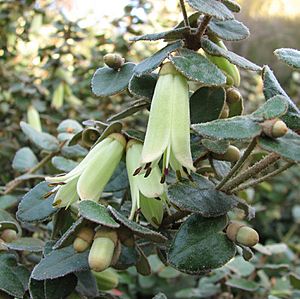Roundleaf correa facts for kids
Quick facts for kids Correa reflexa var. nummulariifolia |
|
|---|---|
 |
|
| Scientific classification |
|
| Kingdom: | Plantae |
| Clade: | Tracheophytes |
| Clade: | Angiosperms |
| Clade: | Eudicots |
| Clade: | Rosids |
| Order: | Sapindales |
| Family: | Rutaceae |
| Genus: | Correa |
| Species: | |
| Varietas: |
C. r. var. nummulariifolia
|
| Trinomial name | |
| Correa reflexa var. nummulariifolia (Hook.f.) Paul G.Wilson
|
|
| Synonyms | |
|
Correa speciosa var. nummulariifolia Hook.f. |
|
The Roundleaf Correa (Correa reflexa var. nummulariifolia) is a special type of plant. It is a variety of the well-known Common correa. This plant only grows in Tasmania, Australia. It is a small shrub, which means it's a bushy plant that doesn't grow very tall.
Contents
Discovering the Roundleaf Correa
This unique plant has leaves that are about 12 to 26 millimeters long. That's roughly the size of a small button! The leaves are also 6 to 15 millimeters wide. Its flowers hang downwards, like little bells. They are shaped like tubes and have a pretty yellow-green color.
Where This Plant Lives
The Roundleaf Correa is quite rare. It only grows on the islands of the Furneaux Group. These islands are located in the Bass Strait, which is the sea channel between mainland Australia and Tasmania. Because it only grows in this specific area, we say it is endemic to these islands.
How It Got Its Name
The Roundleaf Correa was first officially described in 1855. A botanist named Joseph Dalton Hooker gave it its first scientific name, Correa speciosa var. nummulariifolia.
Later, in 1961, another botanist named Paul G.Wilson studied the plant again. He decided it was actually a variety of Correa reflexa. So, he changed its name to Correa reflexa var. nummulariifolia, which is what we call it today.
Important Note for Gardeners
If you see plants called "Roundleaf Correa" in nurseries, be careful! Many of these plants are not the true Correa reflexa var. nummulariifolia. Instead, they are often a very similar plant. This other plant grows near the coastlines of Victoria and northern Tasmania. While they look alike, they are not the exact same variety found on the Furneaux Group islands.

